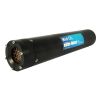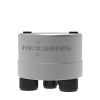Pro-Oceanus Solu-Blu Dissolved CH4 Probe
Features
- Provides continuous 24/7 dissolved CH4 monitoring
- Fully temperature and pressure compensated
- Ideal for groundwater baseline monitoring or lab fermentation studies
- Expedited repair and warranty service
- Lifetime technical support
- More
Overview
The Solu-Blu dissolved CH4 probe can be used for long-term continuous in-situ monitoring to provide dissolved methane data for applications such as groundwater baseline monitoring and laboratory fermentation studies. The probe provides fully temperature and pressure-compensated data. Flow-through and in-line adapters are also available for simple and effective industrial solutions.
Mechanics
The measurement of a gas dissolved in a liquid is facilitated by a semi-permeable membrane that allows gases to transfer from water into a gas head space where the measurement is made. The simple yet rugged sensor allows for the monitoring of methane in a range of environments and liquids. The probe is configured for multiple data output formats to allow for rapid integration into most platforms for data transmission and collection with minimal time and effort.
| Sensor Performance | |
|---|---|
| CH4 Measurement Ranges | 0-30 mg/L 0-3 mg/L 0-300 μg/L |
| Accuracy | |
| CH4 | ± 3% of max range |
| TDGP | ± 0.1% |
| Temperature | ± 0.5º C |
| Equilibration rate (t63): | ~10 minutes |
| TDGP | 10 minutes |
| Resolution pCO2 | 0.1% of max range |
| Physical | |
|---|---|
| Length | 20 cm (8 in) 26 cm with connector |
| Diameter | 5 cm (2 in) |
| Weight | 0.28 kg (0.6 lbs) |
| Housing Material | Acetal Plastic |
| Depth Rating | 0 - 50 meters |
| Water Temperature | -2º to 40º C |
| Electrical | |
|---|---|
| Input voltage | digital: 6-24 VDC analog: 12-24 VDC |
| Power consumption | 0.45 W (35 mA @ 12 V) |
| Data output | RS-232, ASCII format 0-5 V or 4-20 mA |
| Sample rate | 1 second |
In The News
In the Right Place All the Time: Greenhouse Gas Research and NTL-LTER
While researchers all over the globe have been studying greenhouse gases, there are still some areas in the field that have not received as much attention as they deserve. Emily Stanley, professor in the department of integrative biology at the University of Wisconsin and principal investigator for North Temperate Lakes Long Term Ecological Research (NTL-LTER), has spent a significant part of her career exploring a few of them. “Clearly we have a problem with greenhouse gases. What people may not realize is that streams and lakes are hotspots of global methane and CO2. Understanding greenhouse gas dynamics in these systems is important because they are vents all over the world and they are not insignificant,” said Stanley.
Read MoreLong-Term Monitoring in the Chautauqua Lake Watershed
With a widely developed shoreline, Chautauqua Lake experiences influxes of non-point source pollution that have historically impacted the health of the lake. The Chautauqua Lake Association (CLA) has been monitoring the lake for over two decades, reporting on changes that have occurred over the years. A pair of local lake advocates, Jane and Doug Conroe, have lived on the lake for over 40 years and have played an important role in establishing monitoring programs and facilitating consistent data collection throughout the watershed. Doug has been involved with the Chautauqua Lake Association (CLA) since the pair moved to the area in 1980, and is currently serving as the Executive Director.
Read MoreNo Red Herrings: Data Driving the Largest Salt Marsh Restoration in the NE USA
The Herring River system encompasses around 1,000 acres in the Towns of Wellfleet and Truro, Massachusetts. In 1909, the Chequessett Neck Road dike was built at the river’s mouth, drastically limiting tidal flow. Today, it’s one of the most restricted estuaries in the northeastern United States. As a result, the area has suffered environmental decline, including poor water quality, hypoxia, lower pH, and salt marsh degradation. In 2023, the Town of Wellfleet received $14.7 million from NOAA’s Office of Habitat Conservation to fund the Herring River Restoration Project (HRRP). Francesco Peri, President and CEO at Charybdis Group LLC, uses a network of NexSens data loggers to monitor water level and water quality on the Herring River.
Read More
















